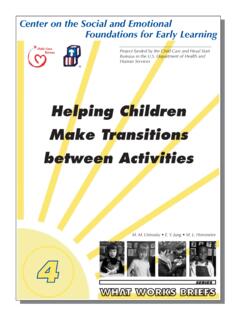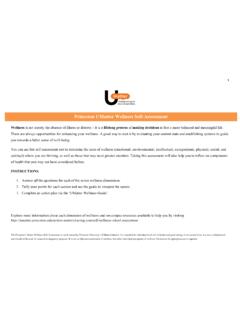Transcription of Chapter 1: What is maths? And why do we all need it?
1 Chapter 1: What is maths? And why do we all need it?From The Elephant in the Classroom: helping Children Learn & Love Maths by Jo Boaler, published by Souvenir Press, my different research studies I have asked hundreds of children, taught traditionally, to tell me what maths is. They will typically say such things as numbers or lots of rules . Ask mathematicians what maths is and they will more typically tell you that it is the study of patterns or that it is a set of connected ideas . Students of other subjects, such as English and science, give similar descriptions of their subjects to experts in the same fields. Why is maths so different? And why is it that students of maths develop such a distorted view of the subject?Reuben Hersh, a philosopher and mathematician, has written a book called What is Mathematics, Really? in which he explores the true nature of mathematics and makes an important point - people don t like mathematics because of the way it is mis-represented in school.
2 The maths that millions of school children experience is an impoverished version of the subject that bears little resemblance to the mathematics of life or work, or even the mathematics in which mathematicians engage. What is mathematics, really?Mathematics is a human activity, a social phenomenon, a set of methods used to help illuminate the world, and it is part of our culture. In Dan Brown s best-selling novel The DaVinci Codei, the author introduces readers to the divine proportion, a ratio that is also known as the Greek letter phi. This ratio was first discovered in 1202 when Leonardo Pisano, better known as Fibonacci, asked a question about the mating behavior of rabbits. He posed this problem:A certain man put a pair of rabbits in a place surrounded on all sides by a wall. How many pairs of rabbits can be produced from that pair in a year if it is supposed that every month each pair begets a new pair which from the second month on becomes productive?
3 The resulting sequence of pairs of rabbits, now known as the Fibonacci sequence, is 1, 1, 2, 3, 5, 8, 13, ..Moving along the sequence of numbers, dividing each number by the one before it, produces a ratio that gets closer and closer to , also known as phi, or the golden ratio. What is amazing about this ratio is that it exists throughout nature. When flower seeds grow in spirals they grow in the ratio :1. The ratio of spirals in seashells, pinecones and pineapples is exactly the same. For example, of you look very carefully at the photograph of a daisy below you will see that the seeds in the center of the flower form spirals, some of which curve to the left and some to the you map the spirals carefully you will see that close to the center there are 21 running anti-clockwise. Just a little further out there are 34 spirals running clockwise. These numbers appear next to each other in the Fibonnacci showing 21 anti-clockwise showing 34 clockwise spiralsRemarkably, the measurements of various parts of the human body have the exact same relationship.
4 Examples include a person s height divided by the distance from tummy button to the floor; or the distance from shoulders to finger-tips, divided by the distance from elbows to finger-tips. The ratio turns out to be so pleasing to the eye that it is also ubiquitous in art and architecture, featuring in the United Nations Building, the Greek Parthenon, and the pyramids of most mathematics students in secondary schools about these relationships and they will not even know they exist. This is not their fault of course, they have never been taught about them. Mathematics is all about illuminating relationships such as those found in shapes and in nature. It is also a powerful way of expressing relationships and ideas in numerical, graphical, symbolic, verbal and pictorial forms. This is the wonder of mathematics that is denied to most children. Those children who do learn about the true nature of mathematics are very fortunate and it often shapes their lives.
5 Margaret Wertheim, a science reporter for The New York Times, reflects upon an Australian mathematics classroom from her childhood and the way that it changed her view of the world:When I was ten years old I had what I can only describe as a mystical experience. It came during a math class. We were learning about circles, and to his eternal credit our teacher, Mr Marshall, let us discover for ourselves the secret image of this unique shape: the number known as pi. Almost everything you want to say about circles can be said in terms of pi, and it seemed to me in my childhood innocence that a great treasure of the universe had just been revealed. Everywhere I looked I saw circles, and at the heart of every one of them was this mysterious number. It was in the shape of the sun and the moon and the earth; in mushrooms, sunflowers, oranges, and pearls; in wheels, clock faces, crockery, and telephone dials. All of these things were united by pi, yet it transcended them all.
6 I was enchanted. It was as if someone had lifted a veil and shown me a glimpse of a marvelous realm beyond the one I experienced with my senses. From that day on I knew I wanted to know more about the mathematical secrets hidden in the world around many students who have sat through maths classes would describe mathematics in this way? Why are they not enchanted, as Wertheim was, by the wonder of mathematics, the insights it provides into the world, the way it elucidates the patterns and relationships all around us? It is because they are misled by the image of maths presented in school mathematics classrooms and they are not given an opportunity to experience real mathematics. Ask most school students what maths is and they will tell you it is a list of rules and procedures that need to be Their descriptions are frequently focused on calculations. Yet as Keith Devlin, mathematician and writer of several books about maths points out, mathematicians are often not even very good at calculations as they do not feature centrally in their work.
7 Ask mathematicians what maths is and they are more likely to describe it as the study of vEarly in his book The math Gene Devlin tells us that he hated maths in his English primary school. He then recalls his reading of Sawyer s book Prelude to Mathematics during secondary school that captivated his thinking and even made him start considering becoming a mathematician himself. Devlin quotes the following from Sawyer s book: Mathematics is the classification and study of all possible patterns. Pattern is here used in a way that everybody may agree with. It is to be understood in a very wide sense, to cover almost any kind of regularity that can be recognized by the mind. Life, and certainly intellectual life, is only possible because there are certain regularities in the world. A bird recognizes the black and yellow bands of a wasp; man recognizes that the growth of a plant follows the sowing of a seed. In each case, a mind is aware of pattern.
8 Vi Reading Sawyer s book was a fortunate event for Devlin, but insights into the true nature of mathematics should not be gained in spite of school experiences, nor should they be left to the few who stumble upon the writings of mathematicians. I will argue, as others have done before me, that school classrooms should give children a sense of the nature of mathematics, and that such an endeavor is critical in halting the low achievement and participation that is so commonplace. School children know what English literature and science are because they engage in authentic versions of the subjects in school. Why should mathematics be so different?viiWhat do mathematicians do, really? Fermat s Last Theorem, as it came to be known, was a theory proposed by the great French mathematician, Pierre de Fermat, in the 1630 s. Proving (or disproving) the theory that Fermat set out became the challenge for centuries of mathematicians and caused the theory to become known as the world s greatest mathematical problem.
9 Viii Fermat was born in 1603 and was famous in his time for posing intriguing puzzles and discovering interesting relationships between numbers. Fermat claimed that the equation an +bn = cn has no solutions for n when n is greater than 2 and a non zero integer. So, for example, no numbers could make the statement a3 +b3 = c3 true. Fermat developed his theory through consideration of Pythagoras famous case of a2 +b2 = c2. School children are typically introduced to the Pythagorean formula when learning about triangles, as any right-angled triangle has the property that the sum of squares built on the two sides (a2 +b2) is equal to the square of the hypotenuse c2. So, for example, when the sides of a triangle are 3 and 4 then the hypotenuse must be 5 because 32 +42 = 52. Sets of three numbers that satisfy Pythagoras case are those where two square numbers (eg 4, 9, 16, 25) can combine to produce a was intrigued by the Pythagorean triples and explored the case of cube numbers, reasonably expecting that some pairs of cubed numbers could be combined to produce a third cube.
10 But Fermat found this was not the case and the resulting cube always has too few or too many blocks, for example:93 + 103 123 729 + 1000 1728 The sum of the volumes of cubes of dimension 9 and 10 almost equals the volume of a cube of dimension 12, but not quite (it is one short!).Indeed Fermat went on to claim that even if every number in the world was tried, no-one would ever find a solution to a3 +b3 = c3 nor to a4 +b4 = c4, or any higher power. This was a bold claim involving the universe of numbers. In mathematics it is not enough to make such claims, even if the claims are backed up by hundreds of cases, as mathematics is all about the construction of time-resistant proofs. Mathematical proofs involve making a series of logical statements from which only one conclusion can follow and, once constructed, they are always true.









